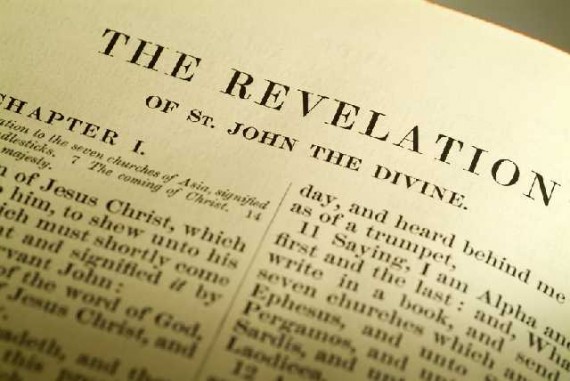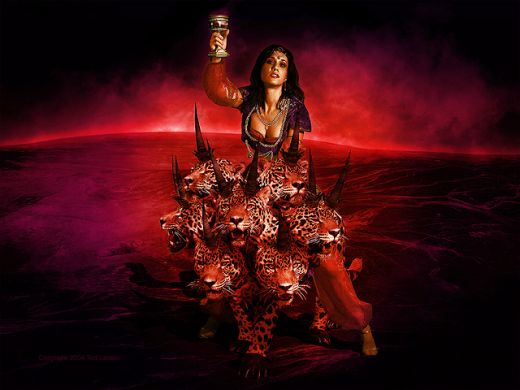 We Christians are wacko.
We Christians are wacko.
A few weeks ago, when I first heard about Herman Cain’s 999 plan, my first thought was, “I wonder how long before we see some churches and Christians decrying Herman Cain for being the Antichrist?”
Well, it was only a few days later in the New Hampshire Presidential debate, that Michelle Bachmann said, “When you take the 9-9-9 plan and you turn it upside won, the devil is in the details.” She was implying, of course, that when you turn 999 upside down, you end up with 666.
And now, if you search Google for “Cain 666”, such statements are all over the internet, including ideas that this plan will turn into some sort of restriction on buying and selling, and everything else that the Book of Revelation says about the Mark of the Beast.
So, that is partly why I am excited to be reading Richard Bauckham’s book, The Theology of the Book of Revelation.
I read the first two chapters this weekend. Supposedly the book is a defense of Preterism, which is the idea that most of the book of Revelation is about historical events that happened around the time of writing in the first century AD. This is not how I have ever thought or taught about the book of Revelation, but if that is what Bauckham’s book is about, so far, I don’t have much to disagree with.
Does that make me a preterist? We’ll see.
One thing is for sure: we need some sanity when it comes to discussing Revelation. I am tried of hearing doomsday prophecies, and having everybody from George Soros to Herman Cain being labeled “the antichrist.” From what I have read so far, it appears that Bauckham’s book may help people move toward a more sane reading Revelation.

Reading the Book of Revelation
In chapter 1, Bauckham introduces the book of Revelation. He writes about prophecy and apocalyptic literature. He made a minor statement about Revelation being a carefully composed literary work (p. 3) which I took slight exception to. I think it was an actual revelation from Jesus Christ, maybe something closer to a dictation, than a carefully composed and edited literary masterpiece, but it’s a minor point. At least Bauckham thinks that John really wrote Revelation, which is (p. 11), which is sometimes contested by scholars.
Purpose of the Book of Revelation
The real importance to this first chapter is that it shows the purpose of the book of Revelation for John and his initial readers. Bauckham believes that it was written to dethrone the world of Roman power and ideology, in which the righteous suffer, the wicked flourish, and the world is ruled by evil, not by God (pp. 7-8). In the face of all this powerful evil, the question the early Christians were asking is, “Where is God’s kingdom?” and John writes the book of Revelation as an answer.
The Imagery of the Book of Revelation
But John doesn’t just answer this question. He shows the answer through numerous images.
John’s vision creates a single symbolic universe in which its readers may live for the time it takes them to read the book. …Readers can enter [this world] so fully that it affects them and changes their perception of the world (p. 10).
This is a key idea, and not just for reading the book of Revelation, but for reading the entire Bible. While I believe that the Bible is historically accurate, and can tell us what happened “back then,” I believe that the primary function for Scripture is to help us creatively imagine a new way of living today. And the imagery that John chose was not random imagery, but was carefully selected images from three sources: Old Testament prophetic imagery, Roman political and military imagery, and the contemporary mythological imagery of that day (pp. 17-19).
It might be like me telling a story about a fig tree and an eagle dancing with the stars. This image would be pure nonsense to someone who did not know that the “fig tree” is an Old Testament image for Israel, and the Eagle is a contemporary symbol for the United States, and Dancing with the Stars is a popular television show. As it is, even when we know what the images stand for, the symbolism is unclear unless I were to provide a carefully composed and edited literary masterpiece describing why and how the fig tree and the eagle were dancing with the stars.
Seven Introductions to the Book of Revelation
Another key point out of chapter 1 is that the seven letters to the churches function as seven introductions to the book, providing seven different perspectives (p. 14), and therefore, seven different meanings or applications. I had never looked at the letters to the seven churches this way, but it gives me hope that even if the book of Revelation turns out to be a book about past events, there can still be a critically important message in the book for us today.
The One Who is and Who Was and Who Is to Come
Chapter 2 was all about Jesus. This was fitting, since the book is from Him and by Him.
Bauckham begins by showing how John equates Jesus with God, making a great case for the divinity of Jesus (pp. 23-30). But my main interest in the chapter was with the discussion about the identity of the Woman and the Beast in Revelation 13-17.
The Woman who Rides the Beast

Bauckham identifies the woman (Babylon the Whore) with the Roman Empire, and the Beast is the military might of the Roman Empire. This actually is not a new idea to me, and I have long believed and accepted this.
The woman is rich, and became so by riding the beast to military victory and the economic exploitation of those who were defeated. Those whom the woman kills are not just Christians, but all who fail to submit to Roman power and who refuse to glorify her violence and profits.
I will admit that as I was reading about the Woman and the Beast, I got the uncomfortable feeling that someone could easily substitute “United States” for “Roman Empire” and come up with similar themes and imagery. Maybe a Preterist reading of Revelation does not make the book irrelevant at all…
The Rest of Chapter 2
I’ll be honest. I didn’t really get the point of the rest of chapter 2. Bauckham talked a lot about the sovereignty and transcendence of God, which are great themes, and clearly present in the book of Revelation, but as I read, I kept asking myself why John would need all this elaborate imagery to say this? If Preterism explains away most of the elaborate imagery of Revelation by simply saying that it reveals the sovereignty and transcendence of God, my question is, “Why go to all the trouble?”
Maybe such ideas could get you in trouble in the Roman Empire, and so John had to hide the ideas behind such imagery, but other New Testament books contain clear statements about the sovereignty of God, and so I just don’t think that this was all John was trying to say.
Or maybe I have misread Bauckham. Did you read chapter 2? What were your thoughts?
Also, here are some links to others who are reading and writing about the same book. Go check out their posts, and see what they had to say about the first two chapters of this book.
- Anthony Ehrhardt
- Peter Bowyer
- Mike Beidler




Hey Jeremy!
Now you’ve got me fascinated to hear an exhaustive version of your vision (Israel – U.S. – and Dancing With the Stars). 😉
M.
Mark,
Ha!
I actually did come up with a little story about 4 lions, an eagle, and a tree. I am not sure I will post it though…
Hmmm – Cain, Bachman and Bauckham. Maybe they’re all mentioned in the book of Revelation. Surely someone has figured this out.
Isn’t it interesting how through the centuries people have been finding references to various contemporary events and people in the book of Revelation?
Is it possible that the revelation had a contemporary “fulfillment” in the Roman Empire, and similar to many other revelations and prophecies, has had and/or will have additional “fulfillments” at later dates, some of which may have yet to happen?
Sam,
Yes, I think so. I am not sure if this is where Bauckham will go with it, but I might be comfortable with such a view.
It doesn’t count if Michelle Bachmann says it. Everything she says is insane. lol
I almost want to lean towards the Nero/ Domitian argument for that passage or the fact that there are numerous types of “antichrists”. It is hard to top Hitler.
How about Mao or Pol Pot? How come they get no love?
🙂 Or Stalin.
You’re right! Stalin might have all of them beat. Yet that’s who a lot of the OWS movement is praising.
Let the Holy Ghost lead you like you are supposed to be lead through the teachings from our God and High Priest, Like is written.
I say blame the democrats cause g-d knows old Herman is not going to take the wrap for this one. If all is proven true, then Cain might as well bow out right now because he wont be winning the republican nomination let alone the national elections. The man cant keep his mouth shut. His attempts to sell his cheap books has made him a joke and nothing more. But this could be good for the democrats because that would mean the nomination run would be between Rick Perry, who has clearly proven himself completely insane…and Romney, who has already declared his allegiance to big business. Believe me I don’t mind my president having some the occasional hooker and blow party but there is a time for everything.
I personally really like Herman Cain. But no matter what, it is going to be an interesting election.
I like Herman Cain too, and he almost had a chance of making me leave the Ron Pau camp, but he RAN the federal reserve for 2 years! So, my trust in him diminished.
He ran the Federal Reserve? He was the chairman like Paulson is now?
Yuppers
May I have the name of the artist for the image used “woman Riding Beasts” or “Whore of Babylon”? It’s quite an eye catcher and I’d like to see other works of the same artist.
Ku,
I looked and looked for it as well, but could not find it. I pulled the image from Google Images. If you find the name of the artist, please let me know because I would like to give them credit on this post.
The artist is Ted Larson he is a biblical artist 🙂
cheers hope that helps
It does help. I will add the credits to the image. Thanks!